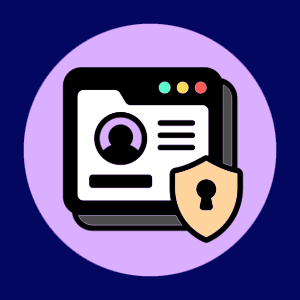 Your domain name is more than just a web address—it’s a critical asset that represents your brand’s identity, credibility, and trustworthiness. The consequences of compromised domains can be devastating, from financial loss to significant damage to your reputation. To help safeguard your brand, we’ve compiled this comprehensive guide to domain protection strategies.
Your domain name is more than just a web address—it’s a critical asset that represents your brand’s identity, credibility, and trustworthiness. The consequences of compromised domains can be devastating, from financial loss to significant damage to your reputation. To help safeguard your brand, we’ve compiled this comprehensive guide to domain protection strategies.
1. Use a Reputable Domain Registrar
Choosing the right domain registrar is your first line of defense. A trustworthy registrar offers advanced security features that protect your domain from unauthorized access or malicious activities. When selecting a registrar, look for key features like:
- Secure Account Management: Ensure the registrar offers secure account access with features like two-factor authentication (2FA).
- Privacy Protection: A good registrar provides privacy services to shield your contact details from WHOIS databases.
- Customer Support: Make sure they offer responsive and knowledgeable support for emergencies.
Investing in a reliable registrar might be slightly more expensive, but it’s a small price to pay for enhanced security.
2. Enable Domain Locking
Domain locking is a simple yet effective way to prevent unauthorized changes to your domain. This feature restricts the ability to transfer your domain to another registrar or alter DNS settings without your explicit approval. Most reputable registrars offer domain locking as a standard security measure, so take advantage of it to keep your domain secure.
3. Implement Multi-Factor Authentication (MFA)
Your domain registrar account should be protected with more than just a password. Multi-Factor Authentication (MFA) adds an extra layer of security by requiring additional verification—such as a one-time code sent to your phone or generated through an authenticator app—before accessing your account. This makes it significantly harder for cybercriminals to compromise your domain.
4. Activate Domain Privacy Protection
When you register a domain, your contact information—name, email, phone number, and address—is often published in public WHOIS databases. This makes it easy for scammers and spammers to target you. Domain privacy protection replaces your personal details with those of a privacy service, reducing the risk of spam, phishing attacks, or unwanted solicitations. Many registrars offer this as a built-in feature, so make sure it’s enabled for your domains.
5. Regularly Monitor and Renew Domain Names
A domain that expires unexpectedly can be hijacked, leading to significant headaches for you and your customers. Set reminders to renew your domain well before its expiration date. Most registrars allow you to enable automatic renewals, which is a great way to avoid any lapse in ownership. Additionally, consider setting up a monitoring service to track changes to your domain information, alerting you to any unauthorized updates.
6. Use DNS Security Extensions (DNSSEC)
DNS Security Extensions (DNSSEC) provide an added layer of security by validating DNS information to ensure its authenticity. This reduces the risk of DNS attacks like cache poisoning, where malicious data is inserted into a DNS resolver’s cache. Enabling DNSSEC ensures that visitors to your site reach the correct destination without interference.
7. Be Aware of Typo-squatting and Register Similar Domains
Typo-squatting is when malicious actors register domain names similar to yours, often with common misspellings or alternate top-level domains (TLDs), to lure your customers to fake sites. To combat this:
- Register Similar Domains: Purchase domains with variations of your primary name to prevent bad actors from using them.
- Monitor Domain Registrations: Use services that alert you if someone registers domains that resemble yours.
By taking these steps, you can stay ahead of typo-squatters and protect your brand’s integrity.
8. Employ SSL/TLS Certificates
SSL/TLS certificates encrypt communication between your website and its visitors, safeguarding sensitive information from eavesdroppers. Having an SSL certificate is not only essential for security but also for SEO, as search engines prioritize secure sites. Consider investing in an Extended Validation (EV) certificate, which offers the highest level of trust by validating your organization’s identity.
9. Monitor for Unauthorized Domain Changes and Domain Takeovers
Unauthorized changes to DNS settings or registrar information can disrupt your business and lead to data breaches. Use monitoring tools to track modifications to DNS records, WHOIS data, and other domain information. Set up alerts for unauthorized changes so you can act quickly to mitigate any risks.
10. Educate Your Team
Your domain security is only as strong as the weakest link in your organization. Training employees on best practices—like creating secure passwords, avoiding phishing scams, and recognizing social engineering tactics—can go a long way in protecting your domain. Make sure that anyone who has access to domain settings is aware of potential threats and understands the steps to mitigate them.
Conclusion
Securing your domain is not a one-time task but an ongoing process that requires vigilance, proactive measures, and regular updates. By following the strategies outlined in this guide, you can protect your brand’s online identity, ensuring that your business remains safe from threats. Regularly auditing your domain’s security measures will keep you ahead of emerging risks and ready to defend your digital turf.
